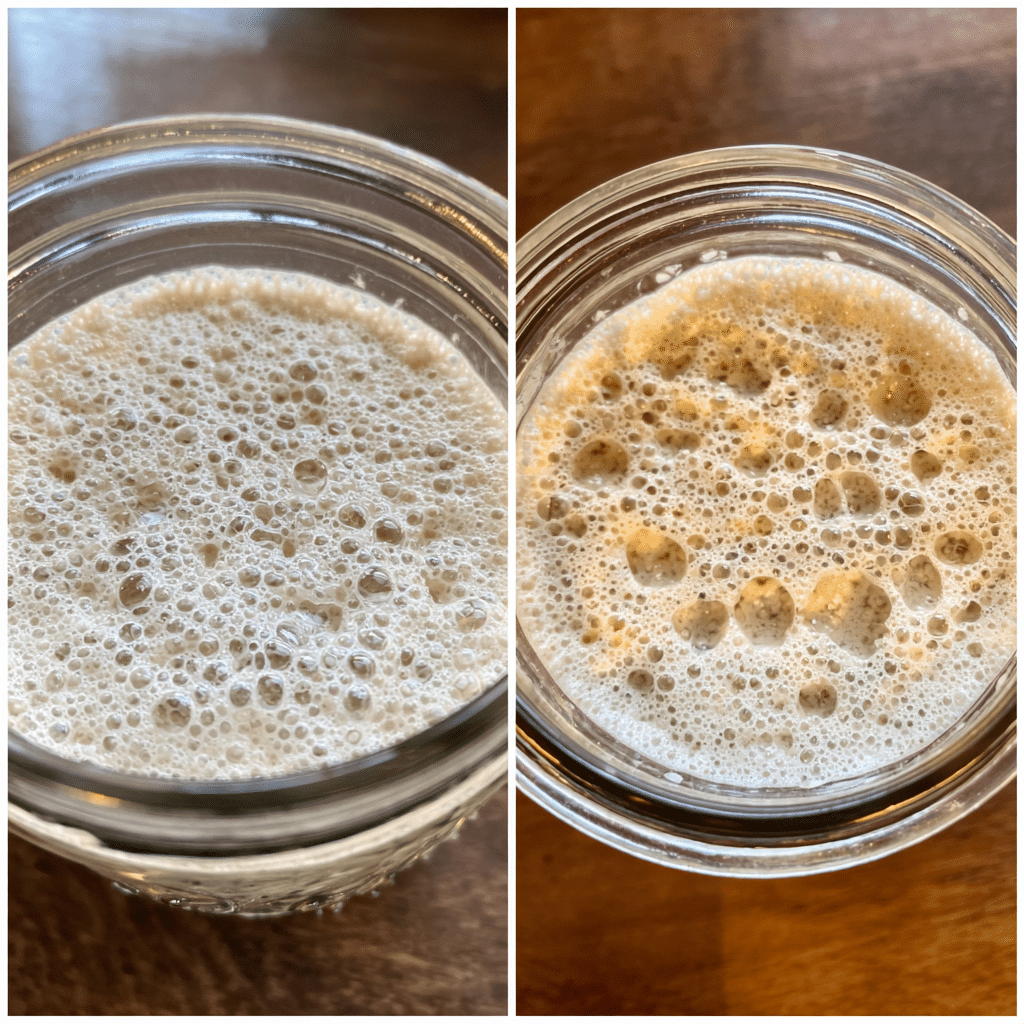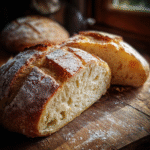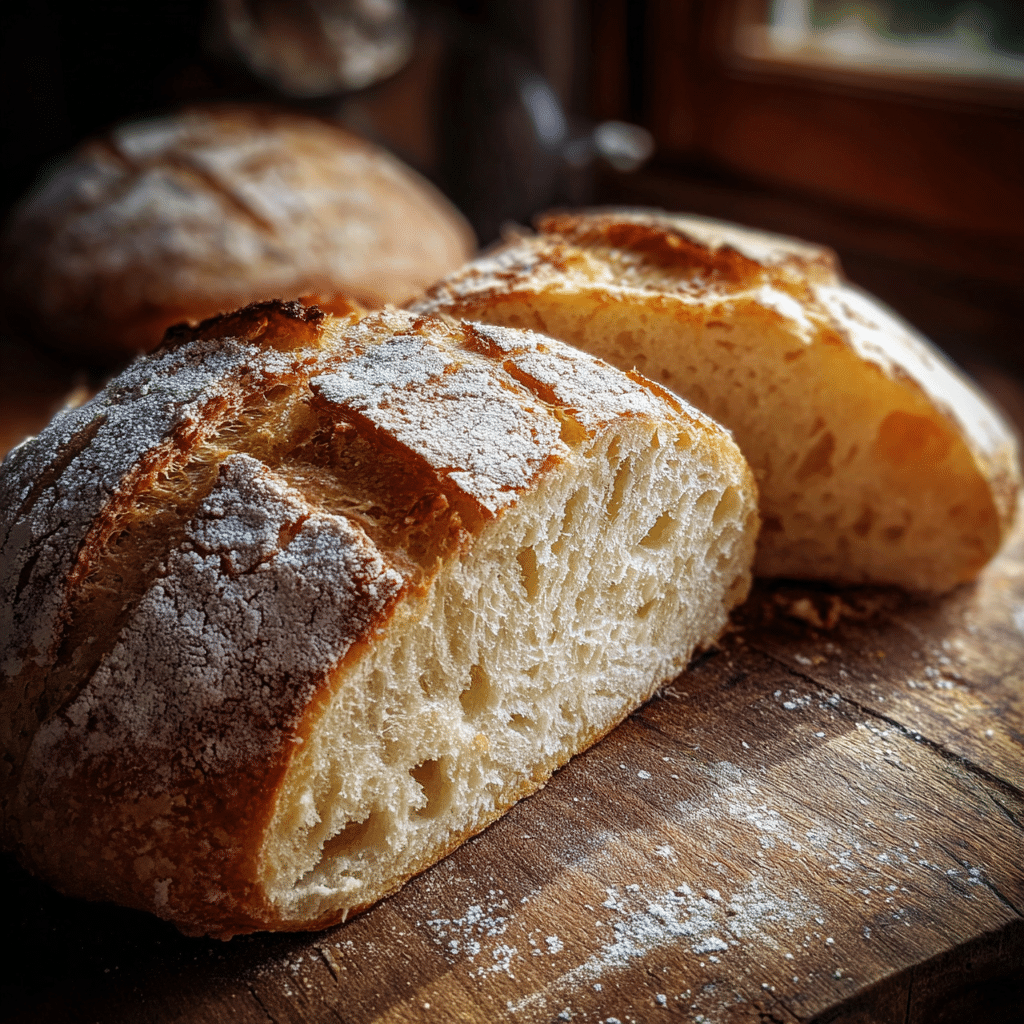Low FODMAP sourdough isn’t just a trendy term it’s a practical solution for people dealing with digestive struggles, especially those navigating IBS. As a recipe developer who’s obsessed with gut-friendly alternatives and has tested countless sourdoughs in my kitchen, I’ve learned that not all loaves are created equal. Some sourdoughs can actually help reduce bloating and discomfort, while others are a hidden minefield of high-FODMAP ingredients. In this guide, we’ll dive deep into whether sourdough is safe for low FODMAP diets, how fermentation changes its impact, and what options are best when you’re buying or baking.
Thank you for reading this post, don't forget to subscribe!Discover great ideas like this sourdough discard recipe to keep your gut happy and your cravings satisfied.
Let’s break down the truth about sourdough and FODMAPs from myths to science to smart shopping and home baking.
Table of Contents
What Is Low FODMAP Sourdough?
Understanding FODMAPs and Digestive Health
If you’re on a low FODMAP diet, chances are you’ve heard that bread especially anything with wheat should be avoided. But let’s break that down. FODMAPs are a group of fermentable carbohydrates (Fermentable Oligosaccharides, Disaccharides, Monosaccharides, and Polyols) that can trigger bloating, gas, and discomfort, especially for those with IBS. They’re found in a wide range of foods, including garlic, onions, beans, dairy, and yes wheat-based bread.
The good news? Not all bread is off-limits.
Low FODMAP sourdough is a unique exception, thanks to the magic of long fermentation. During this process, natural bacteria and yeast break down many of the problematic carbs, including fructans (one of the main FODMAPs in wheat flour). This is why many people with IBS find sourdough easier to digest compared to regular white or whole wheat bread.
How Traditional Sourdough Fermentation Reduces FODMAP Levels
The secret behind low FODMAP sourdough lies in how it’s made. Real sourdough is fermented for 12 to 48 hours using a live sourdough starter. That starter is a powerhouse of lactobacilli and wild yeasts that feast on sugars and ferment the dough slowly, breaking down:

- Fructans (FODMAPs) – These are reduced significantly as the bacteria feed on them.
- Gluten proteins – While sourdough isn’t gluten-free, long fermentation weakens gluten strands, making them easier on the gut.
- Phytic acid – The anti-nutrient that blocks mineral absorption is also reduced.
Here’s a quick comparison:
| Bread Type | Fermentation Time | FODMAP Level |
|---|---|---|
| Commercial White Bread | 1-2 hours | High |
| Traditional Sourdough Bread | 12-48 hours | Low |
| Gluten-Free Bread (w/o FODMAP filter) | Varies | Medium-High (depends on ingredients) |
If you’re buying sourdough or making it at home, look for long fermentation, no commercial yeast, and ideally organic flours. That’s where the real FODMAP magic happens.
Discover great ideas like this gluten-free sourdough bread to bake gut-friendly loaves right in your kitchen.
Low FODMAP sourdough doesn’t just taste better it feels better, especially for your digestive system.
Print
Low FODMAP Sourdough: What It Is and How to Make It at Home
- Total Time: 1 hour 15 minutes + fermentation
- Yield: 1 loaf (8–10 slices)
Description
This guide explores everything you need to know about low FODMAP sourdough – from digestive benefits to fermentation science, and how to make it gut-friendly at home.
Ingredients
- White spelt flour or light rye flour
- Filtered water
- Sea salt
- Active sourdough starter (made with white or spelt flour)
- Optional: gluten-free flour blends (avoid soy or coconut)
Instructions
- Mix flour, water, and starter to form a shaggy dough.
- Let the dough rest (autolyse) for 30–60 minutes.
- Add salt and incorporate into the dough.
- Bulk ferment the dough at room temperature for 12–24 hours.
- Shape and place the dough in a proofing basket.
- Cold proof in the fridge for 8–12 hours.
- Preheat oven with Dutch oven inside at 475°F (245°C).
- Score the loaf and bake covered for 20 minutes, then uncovered for another 20–25 minutes.
- Cool completely before slicing.
Notes
For optimal digestion, always use a long fermentation process. Stick to 1 slice (50g) servings if sensitive to FODMAPs. Avoid commercial yeast and fast-fermentation methods.
- Prep Time: 30 minutes
- Cook Time: 45 minutes
- Category: Bread
- Method: Baking
- Cuisine: Gut-Friendly
Is Sourdough Bread Low FODMAP? The Scientific View
Fermentation and FODMAP Breakdown Explained
So how exactly does sourdough go from a high-FODMAP wheat product to a gut-friendlier bread? The transformation happens during fermentation.
When sourdough is fermented the right way slowly and naturally it goes through a biochemical process where wild yeasts and lactic acid bacteria break down sugars, proteins, and even FODMAPs like fructans. This is what makes low FODMAP sourdough not just a marketing term but a scientific reality.
Research has shown that long fermentation reduces the content of short-chain carbohydrates, specifically:
- Fructans – Major triggers for IBS symptoms, significantly reduced by 80–90% in properly fermented sourdough.
- Lactose (in dairy-added doughs) – Broken down by bacteria during fermentation.
- Galacto-oligosaccharides (GOS) – Also targeted by the natural fermentation process.
In a study conducted by Monash University, the world leader in FODMAP research, it was found that sourdough spelt bread fermented for 20–24 hours tested as low FODMAP in one slice servings.
That means your daily slice of toast doesn’t have to feel like Russian roulette for your gut anymore.

What Research Says About IBS and Sourdough Consumption
Several clinical studies and dietitian-led trials support the tolerability of sourdough for people following a low FODMAP diet. Here’s what the science says:
- Monash University tested various types of sourdough and found that bread made from white, wholemeal, and spelt flours using natural fermentation methods consistently showed lower FODMAP levels than commercial bread.
- A 2019 clinical review published in Nutrients Journal confirmed that fermented foods like sourdough may improve gastrointestinal health, even aiding in microbiota diversity a known gut health marker.
While results can vary depending on the recipe and length of fermentation, sourdough that’s naturally leavened and fermented for at least 12–24 hours often falls within the low FODMAP range for a typical serving (1 slice or 50g).
Check out how I use my discard to make low-FODMAP friendly recipes like these sourdough discard soda breads that are lighter on the gut but full of flavor.
What’s most exciting is that you don’t have to cut out bread to feel good you just need to choose the right kind
Low FODMAP Sourdough for IBS: What You Need to Know
Is Sourdough Bread Bad for IBS Sufferers?
If you live with IBS, bread can feel like the enemy. The bloating, cramping, and unpredictable gut reactions are enough to make anyone swear off carbs. But here’s the good news not all bread is created equal, and sourdough might just be your gut’s best-kept secret.
So, is sourdough bread bad for IBS sufferers? Not necessarily.
The answer depends on the type of sourdough, the ingredients, and most importantly, the fermentation process.
Unlike commercial bread, which is often made with added yeast and lacks proper fermentation, traditional sourdough allows natural bacteria to do their job. This fermentation breaks down FODMAP-rich compounds like fructans, which are major IBS triggers.
According to digestive health experts and Monash University, long-fermented sourdough breads (especially those made with spelt, white, or rye flours) are often well-tolerated by IBS patients when eaten in moderation.
That means instead of cutting out bread completely, you can simply choose smarter.
Why Some IBS Patients Tolerate Sourdough Better Than Other Breads
Ever wondered why sourdough doesn’t hit your gut as hard as other loaves? It’s not just in your head. Here’s what makes low FODMAP sourdough more IBS-friendly:
- Reduced Fructan Load: Long fermentation time reduces fructans by up to 90%, especially when using spelt flour.
- Natural Acids Help Digestion: Lactic and acetic acid produced during fermentation aid digestion and stabilize gut bacteria.
- Weakened Gluten Structure: Although not gluten-free, sourdough contains partially broken-down gluten, making it easier to tolerate for some.
Anecdotally and clinically, many IBS sufferers report that they can tolerate 1 slice (about 50g) of sourdough bread per meal without symptoms. The key is choosing authentic sourdough made with slow fermentation and clean ingredients.
Looking for inspiration? Try these real food recipes like sourdough pita chips made from scratch using discard they’re crispy, flavorful, and gentle on your belly.
Remember, IBS is highly individual. But if you’ve been avoiding bread altogether, sourdough might be the safe middle ground your gut’s been waiting for.
Supermarket vs Homemade: Which Sourdough Is Low FODMAP?
Is Supermarket Sourdough Really Authentic?
Let’s cut to the chase: most supermarket sourdough isn’t real sourdough. While it might say “sourdough” on the label, that doesn’t mean it’s low FODMAP or made using traditional fermentation methods.
The majority of store-bought “sourdough” loaves are manufactured quickly, using commercial yeast and sour flavoring agents. These shortcuts may save time, but they skip the long fermentation process that helps reduce FODMAPs, making the bread harder to digest especially for IBS sufferers.
So, is supermarket sourdough low FODMAP? In most cases, the answer is no.
Here’s what to check for on the label:
| Look For | Avoid |
|---|---|
| “Long-fermented” or “Naturally leavened” | “Yeast” listed high on ingredient list |
| Ingredients: flour, water, salt, starter | Added sugars, preservatives, vinegar |
| Baked locally or artisan brands | Ultra-processed mass-market loaves |
To be safe, stick to local bakeries or certified low FODMAP sourdough brands or, better yet, learn to bake it at home.
Spotting True Long-Fermented Sourdough vs Fake Loaves
Not all breads labeled “sourdough” are created equal. Here’s how you can spot the difference:
- True sourdough contains minimal ingredients: typically flour, water, salt, and sourdough starter.
- It’s fermented for 12–48 hours, which helps reduce frutans and makes it suitable for low FODMAP diets.
- Fake sourdough often contains baker’s yeast and added acids (like vinegar) to simulate the sour taste but doesn’t offer the same gut-friendly benefits.
Don’t miss our gut-friendly sourdough flavors like this blueberry lemon sourdough bread, made using real, slow-fermented techniques that support a low FODMAP lifestyle.
Homemade bread might take longer, but the digestive payoff is worth it especially when your gut needs gentle foods.
How to Make Low FODMAP Sourdough at Home
Choosing the Right Flour (Spelt, Rye, Gluten-Free Blends)
If you’re ready to bake your own low FODMAP sourdough, choosing the right flour is your first big step. While most sourdough recipes use wheat flour, not all flours behave the same when it comes to FODMAPs.
Here’s how they stack up:
| Flour Type | FODMAP Level (Post-Fermentation) | Best For |
|---|---|---|
| White Spelt | Low (with long fermentation) | Classic low FODMAP sourdough loaf |
| Wholemeal Spelt | Medium | Small servings, needs longer fermentation |
| Light Rye | Low to moderate | Traditional tangy sourdough |
| Gluten-Free Blends | Varies (watch for high-FODMAP ingredients like soy or coconut flour) | Gluten-sensitive bakers |
White spelt flour is a superstar in the low FODMAP world. When properly fermented, it’s consistently rated low FODMAP by Monash University making it a go-to choice for sourdough beginners and gut-conscious bakers alike.
Avoid enriched flours with added inulin, soy flour, or chicory root these can spike FODMAP content and sabotage your digestive comfort.
Sourdough Starter Tips to Reduce FODMAPs
A healthy starter equals a healthy loaf and if you want your sourdough to be low in FODMAPs, your starter must be strong and active.
Follow these best practices:
- Use a white or spelt flour-based starter. Whole wheat starters can retain more FODMAPs.
- Feed your starter regularly. An underfed starter leads to incomplete fermentation.
- Aim for a 12–24 hour bulk fermentation. This allows bacteria and wild yeast time to break down problematic carbs like fructans.
- Maintain warm room temps (around 70–75°F) for optimal fermentation.
Want to use up extra starter in a FODMAP-friendly way? Check out these tasty sourdough discard biscuits for a gut-loving twist on a classic.
Baking at home gives you full control over ingredients and fermentation time two critical factors for making your sourdough truly low FODMAP.
Sourdough and Inflammation: Is It Anti-Inflammatory or Not?
Is Sourdough Bread an Inflammatory Food?
There’s a lot of noise online about bread being “inflammatory,” but here’s the truth: not all bread causes inflammation and low FODMAP sourdough might be one of the exceptions.
Unlike ultra-processed white bread, authentic sourdough is created through natural fermentation, a process that transforms the dough’s structure and even influences how it interacts with your gut and immune system. During fermentation, enzymes break down gluten and starches, while beneficial bacteria increase the bread’s bioavailability of nutrients.
Studies suggest that long-fermented sourdough can have the following anti-inflammatory benefits:
- Lower gluten content, which may reduce immune reactions (especially in non-celiac gluten sensitivity)
- Increased lactic acid, which supports beneficial gut flora
- Improved blood sugar response, helping prevent chronic inflammation associated with spikes and crashes
That means instead of triggering inflammation, real sourdough could actually help support a balanced immune response, especially for people with sensitive digestive systems or autoimmune issues.
However, as always, results may vary based on your personal gut tolerance and the specific sourdough recipe used.
Benefits of Sourdough on Gut Health and Inflammation
Fermented foods have been linked to lower markers of inflammation and better digestive health, and sourdough is no exception. For people on a low FODMAP diet, sourdough is often one of the few “safe” bread options that also supports the gut microbiome.
Here’s how:
- Supports healthy gut bacteria: The lactic acid bacteria in sourdough act as a natural probiotic during fermentation.
- Reduces anti-nutrients: Phytic acid is lowered, improving mineral absorption and reducing potential gut irritation.
- Stabilizes blood sugar: Unlike refined breads, sourdough digests more slowly, leading to steadier energy and less systemic inflammation.
Discover more about sourdough and its blood sugar effects in this post on is sourdough bread healthy for diabetics? a key read if you’re watching inflammation linked to metabolic health.
In short, when prepared traditionally, low FODMAP sourdough isn’t just tolerable it may actively contribute to better digestion, less inflammation, and greater overall well-being.
Conclusion
Low FODMAP doesn’t mean low flavor or low satisfaction. When made the traditional way, low FODMAP sourdough can be a game-changer for anyone dealing with IBS, bloating, or food sensitivities. Thanks to its long fermentation, simpler ingredients, and gut-supportive benefits, sourdough can actually become a staple not something to avoid.
If you’ve been navigating a tricky gut and missing bread, this is your sign to try sourdough the right way. Whether you bake it at home with spelt flour or source it from a trusted bakery, low FODMAP sourdough offers a path back to bread that loves your body as much as your taste buds.
Looking for more recipes that respect your gut?
Follow us on Facebook for fresh new recipes, cooking tips, and food inspiration every week!

FAQ: Low FODMAP Sourdough – Answered
Is sourdough bread ok for low FODMAP?
Yes—when traditionally fermented, sourdough bread can be low in FODMAPs. Breads made with white or spelt flour and fermented for at least 12–24 hours often test as low FODMAP. Just stick to moderate serving sizes—around 1 slice (50g).
Is sourdough bread bad for IBS sufferers?
No, not in most cases. Traditional sourdough is often better tolerated by people with IBS because the fermentation process reduces fructans, one of the major FODMAP triggers. Just be sure the bread is genuine sourdough, not the supermarket kind with added yeast.
Is supermarket sourdough low FODMAP?
Typically, no. Most supermarket sourdough bread is not fermented long enough to significantly reduce FODMAPs. Many commercial loaves are made with yeast and other additives that can irritate sensitive guts. Always read the label or opt for homemade or artisan options.
Is sourdough bread an inflammatory food?
Not necessarily. Real sourdough made with long fermentation tends to be easier on digestion and may even help reduce inflammation by supporting gut bacteria and improving nutrient absorption. Unlike processed bread, sourdough doesn’t spike blood sugar as sharply and can be part of a gut-friendly, anti-inflammatory diet.

